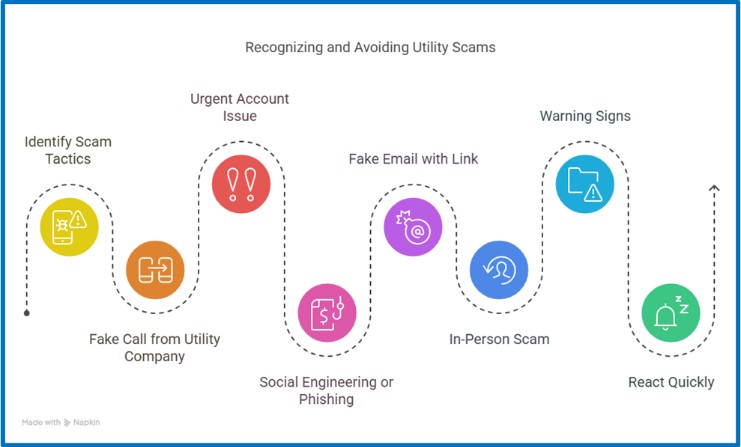Sharing or losing your electric bill might seem like a small error, but it can open the door to different types of fraud, like fraudulent deeds, auto loan fraud, and more. In fact, according to the FTC, total losses from fraud reached $10 billion, with identity theft being the most frequent type.
Talking about what someone can do with your electric bill means looking at a silent threat. In this post, we’ll show you how these bills are used in common scams, what kind of data is at risk, and what to do if you suspect someone has already used your information.
Need support after a scam? Join our community today.
What Information Is Included In An Electric Bill?
When thinking about what someone can do with your electric bill, most people don’t realize how easily it can be used for fraud. Even when it looks like a simple document, it contains enough personal details to confirm your identity and where you live, two things scammers often need.
Here are some of the details an electric bill usually includes:
- Full name of the account holder: Helps identify who’s responsible for the service. Typically, the first detail matched against leaked databases.
- Exact home address: With a verified address, scammers can request credit cards, services, deliveries, or even update records tied to that location.
- Account number: On many websites, this number alone gives access to your user profile or allows someone to change contact details.
- Billed amount and payment dates: Used to make fraudulent activity appear legitimate. Some scammers use these details to request billing extensions or submit fake payments.
- Usage history: Confirms how long you’ve lived at that address — information that moneylenders and identity thieves alike may use.
- Customer or contract number: Frequently required to verify identity through customer service portals, which can make impersonation easier.

What Can Someone Do With Your Electric Bill?
It’s easy to forget how much information a simple electric bill can reveal. But for scammers, it’s more than a utility statement — it’s a building block for convincing fake identities. They’re not trying to access your existing accounts; instead, they use your details to create entirely new, fraudulent identities.
In many cases, they’re trying to build new identities using your data as a guide. That’s where the electric bill becomes useful, as it can be used as a trusted document to gain access or pass verification checks with companies or financial platforms.
1. Signing Up For Services Under Your Name
With an electric bill and an ID number, scammers can sign up for internet, cable, or streaming services, and even write a bad check. Many providers only ask for proof of address and a matching name. If someone gets a copy of your bill, they can impersonate you and add these services to your name.
Most victims don’t find out until they receive an unexpected charge or a credit report shows a defaulted account they’ve never seen.
2. Applying For Store Credit Or Small Loans
Some financial institutions — especially department stores or digital loan platforms — accept electric bills as valid proof of address. When scammers combine that with a fake or stolen ID, getting approved for store credit, loans, or installment plans becomes much easier.
3. Activating Phone Lines
Another common tactic is to use your information to activate SIM cards or mobile lines. These numbers aren’t linked to their real identity and are often used for phishing messages, creating delivery app accounts, or committing other types of fraud. Sometimes they’re only used to receive verification codes for new fake accounts.
4. Identity Theft For Indirect Fraud
Sometimes the goal isn’t to steal from you directly, it’s to use your information to commit fraud on behalf of someone else. Here’s how:
- Registering Someone in Aid Programs: Government programs often ask for proof of address to enroll. If a scammer gets your electric bill, they can register another person and claim benefits they’re not entitled to.
- Carrying Out Bank Transfers: Some banking platforms accept transactions if the documents look legitimate. If they connect your name with other fake credentials, scammers can move funds or create temporary accounts with minimal suspicion.
- Using Your Address For Illegal Deliveries: Scammers use stolen credit cards to purchase goods online, then ship them to addresses found on electric bills. This keeps their real location hidden. As a result, you might receive suspicious packages — or worse, attract shady visits.
How to Know If Someone Is Using Your Electric Bill for Fraud?
A big part of understanding what can someone do with your electric bill is learning how to spot the signs before it’s too late. Scammers constantly shift their tactics, but many of their methods follow familiar patterns.
What Tricks Do Scammers Use to Access Your Data?
- Fake utility calls: A scammer pretends to represent your energy provider and claims there’s an urgent issue with your account. They may use social engineering or phishing tactics to make it feel real and pressure you to act quickly.
- Phishing emails: You might receive a fake email that looks like it’s from your provider, asking you to click a link to “verify your account.” Clicking it may lead to a fraudulent site that steals your data.
- In-person scams: Someone may show up in a fake uniform, claiming to be from the utility company and asking to inspect your home. These visits are meant to collect information or gain access under a pretext, like HVAC scams.
How Can You Recognize a Fake Utility Message or Visit?
These are some warning signs that should help you react quickly:
- They ask for sensitive information out of nowhere.
- They threaten to disconnect your service unless you pay immediately.
- The message or call contains spelling mistakes or uses a pushy, urgent tone.
- They pressure you to pay using gift cards, cryptocurrency, or apps like Zelle.
Have questions about dealing with scams? Contact us for support.

True Stories That Show How Electric Bills Are Used in Scams
Scammers have used electric bills in real cases to steal money, fake identities, and open accounts. These stories show how easy it can be for fraud to start with just one document:
🧾 Case 1: The Fake Energy Provider
According to the FTC, a man pretending to be a legitimate energy provider created a fake electric company using false documentation. For years, he created fake bills under made-up customer names and used them to charge for services that were never delivered.
He focused on people who had recently switched service providers or were preparing to move. To make the scam more convincing, he offered them “special discounts”. Here’s how the fraud worked in practice:
- He requested upfront payments in exchange for the fake services.
- Sent fake invoices that looked nearly identical to those from real energy companies.
- Scammed more than 500 people, collecting over $1 million.
⚖️ Case 2: Utility Company Scheme
According to the Houston Chronicle, Daniel Rodriguez-Martinez, 51, ran a fake utility company from March 2021 to May 2024. He pleaded guilty to wire fraud after using stolen identities to open fraudulent utility accounts.
He connected those accounts to real residential addresses, so his clients could use electricity without being billed themselves. The real account holders were left unidentified until they received the charges. This scheme worked through a consistent process:
- Clients paid $80 per month using apps like Zelle and CashApp.
- He opened new accounts each time one was disconnected for nonpayment.
- The operation generated at least $1.4 million in illegal profits.
How To Protect The Data In Your Electric Bills?
If you’ve read this far and you’re wondering what someone can do with your electric bill, the best answer is: it depends on how well you protect that information. It might look like just another receipt, but it can be used in several types of fraud. The good news is that a few simple actions can help reduce the risk:
1. How To Handle Your Bills Safely
Avoid leaving them visible, storing them for years indefinitely, or throwing them. Here’s what we recommend:
- Scan your bills and get rid of physical copies if you don’t need them anymore.
- If you have to keep them, store them in closed folders or cloud services with authentication.
- Never throw them away whole, cut them up, or better yet, use a shredder.
2. Use Identity Protection Tools
There are services that monitor if your data appears in compromised databases. Some will even alert you if someone tries to open an account using your name or address. Consider using:
- Identity Guard.
- LifeLock.
- Identity monitoring tools are offered by your bank or insurance provider.
3. Be Careful With What You Share
Fraud often starts with something as simple as a call, a suspicious email, or an app request. Before sharing your bill:
- Make sure you know who’s requesting it and why.
- Avoid sending documents without a password or encryption.
- Never post screenshots of your bill on social media, even if some details are blurred.
What To Do If You Suspect a Scam Involving Your Electric Bill?
Once you understand what someone can do with your electric bill, it’s just as important to know what steps to take if you think your information has already been used. If something feels off with your account or you’ve received unexpected bills, let your utility company know right away.
They may be able to review the activity and block any unauthorized changes. Also, report the situation to the Federal Trade Commission (FTC) and your local police, especially if you believe your identity has been stolen.
To make sure your financial information stays safe in the future, think about doing the following:
- Freeze your credit with agencies like Equifax, TransUnion, or Experian.
- Enable alerts on your bank and credit card accounts for any unusual activity.
- Use identity theft protection tools, either through your bank, insurance provider, or a third-party service like LifeLock or Identity Guard.
Protect Your Business: Don’t Let a Simple Bill Become a Risk
If you’re still wondering what someone can do with your electric bill, keep in mind it’s not just about personal identity theft. In a company, one electric bill can be enough to open fake credit lines, create fraudulent profiles, or even run scams in your name.
At Cryptoscam Defense Network, we help companies and users spot and prevent these threats early. From learning how to find legitimate crypto recovery services to avoiding mistakes like putting your Social Security Number in an email, we’ll help you keep fraud away, starting with better control of your utility bills.
We Want to Hear From You!
Fraud recovery is hard, but you don’t have to do it alone. Our community is here to help you share, learn, and protect yourself from future fraud.
Why Join Us?
- Community support: Share your experiences with people who understand.
- Useful resources: Learn from our tools and guides to prevent fraud.
- Safe space: A welcoming place to share your story and receive support.
Find the help you need. Join our Facebook group or contact us directly.
Be a part of the change. Your story matters.

